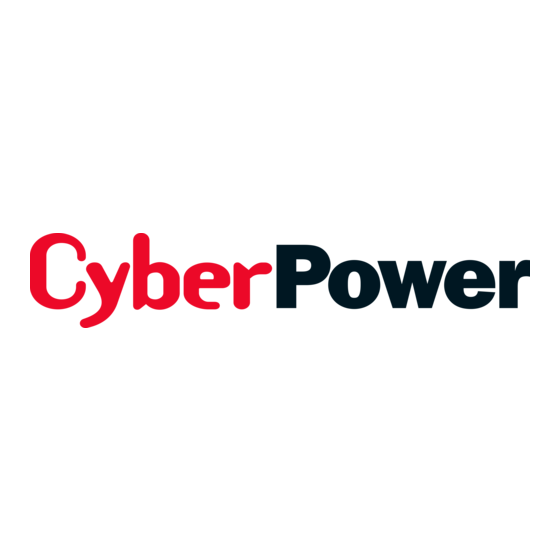
Summarization of Contents
Introductions and Core Technology
Automatic Voltage Regulator (AVR)
Explains how AVR increases low or decreases high voltage to a safe output.
CyberPower GreenPower UPS Technology
Details the patented bypass technology for energy saving and efficiency.
Important Safety Instructions
General Safety Precautions
Read and follow all instructions for installation and maintenance.
Electrical Safety Warnings
Grounding, avoiding shock, circuit protection, and usage restrictions.
Product Overview
Front Panel Components
Identifies and describes the components on the front panel of the UPS.
Rear Panel Components
Identifies and describes the ports and connectors on the rear panel.
Emergency Power Off (EPO) Port
Explains the function and usage of the EPO port for immediate shutdown.
Installation Procedures
Preparation for Installation
Recommends assistance and checks before starting installation.
Rack Installation for 2-post Rack
Step-by-step guide for mounting the UPS in a 2-post rack.
Rack Installation for 4-post Rack
Step-by-step guide for mounting the UPS in a 4-post rack.
Basic Operation and Maintenance
Tower Installation
Instructions for setting up the UPS in a tower configuration.
Normal Use and Battery Connection
Steps for normal operation and connecting the battery.
Powering On and Off the UPS
How to turn the UPS on and off using the LCD module.
Important Usage Notes
Notes on charging, connecting devices, and avoiding extensions.
Grounding the UPS
Procedure to ground the UPS for safety.
Performing a Hard Reboot
Steps to perform a hard reboot if the UPS freezes.
Maintenance Precautions
Safety precautions for cleaning and storing the UPS.
Operation and Storage Environment
Environmental Specifications
Details temperature, humidity, and elevation requirements for operation and storage.
Network Operation and Monitoring
Local Monitoring Setup
Connecting for local monitoring via USB or Serial cable.
Remote Monitoring Requirements
Information on using the SNMP/HTTP network slot with an RMCARD.
Cloud Monitoring Setup
Steps to connect the UPS for cloud monitoring via Ethernet.
Adding Device to PowerPanel Cloud App
Guide to adding the UPS to the PowerPanel Cloud mobile application.
Starting Cloud Monitoring
Accessing the PowerPanel Cloud account via mobile app or web browser.
LCD Operation Guide
Display Interface
Identifies and describes the UPS LCD display and buttons.
Basic Operation
Overview of navigating UPS status using the LCD buttons.
Setting Guide
Explains how to enter and navigate the UPS setup menus.
Basic Setup Menu Options
Details settings like Utility Quality and Sensitivity.
Ambient Setup Menu Options
Customizes UPS display, alarm, and noise settings.
Outlet Control Menu
Configures UPS outlet performance for Critical (CL) and Non-Critical (NCL).
Config UPS Submenu
Settings for total UPS output, including delay and runtime.
Config NCL Submenu
Settings specific to Non-Critical (NCL) outlets for power management.
Menu - Test Options
Instructions for performing Self Test and Alarm Test.
Menu - Logs
How to view event logs (faults, warnings, shutdowns) on the UPS.
Menu - Advanced Setup Options
Detailed settings for output voltage, charging, and battery management.
Advanced Setup - Date, Time, and IP Settings
Configuration of date/time, power meter reset, IP access, subnet, gateway.
Advanced Setup - Firmware and Defaults
Options for firmware updates and restoring factory default settings.
Fault Warning Display and Alarm
Understanding Fault and Warning Codes
Table detailing error codes, display messages, LED indicators, and alarms.
EPO and ROO Configuration
EPO/ROO Interface Installation
Wiring instructions for the EPO/ROO port using normally open or closed switches.
Restriction on ROO Functionality
Rules and conditions for using the Remote On/Off (ROO) feature.
Dry Contact Monitoring
Dry Contact Monitoring Capabilities
Lists UPS statuses monitored via dry contact relays.
Dry Contact Wiring and Application
Explains internal circuit, relay status, and provides an example application.
Battery Replacement
Battery Replacement Safety Precautions
Warnings about explosion risk, energy hazard, and proper disposal.
Battery Replacement Procedure
Step-by-step guide for replacing the UPS battery pack.
Technical Specifications
General and Input Specifications
Details UPS topology, energy saving, input voltage, frequency, and cord length.
Output and Battery Specifications
Power capacity, output voltage/frequency, battery type, and recharge time.
Physical Dimensions and Conformance
Physical size, weight, and compliance certifications (approvals, environmental).
Troubleshooting UPS Issues
UPS Not Providing Power
Solutions for issues like overload, discharged batteries, or damage.
Unexpected Runtime Issues
Causes and solutions for short runtime, high temperature, or worn batteries.
UPS Cannot Be Turned On
Troubleshooting steps for power-on failures, including hard reboot.
PowerPanel Business Inactivity
Solutions for PowerPanel Business software not working.
Display Screen Fault/Error Messages
Guidance on interpreting and resolving display screen messages.
UPS Operation with Generator
Troubleshooting UPS issues when connected to a generator.
Product Disposal
WEEE Disposal Information
Information on disposing of electronic waste according to WEEE directive.
Battery Disposal Guidelines
Instructions for disposing of lithium-ion batteries as hazardous waste.
Regulatory Compliance
FCC and Canadian Compliance Statements
Statements regarding FCC and Canadian compliance for PRL1500RT2UC and PRL3000RT2UC.
VCCI Compliance Statements
Statements regarding VCCI compliance for both UPS models.
DOE and ENERGY STAR Compliance
Details on Department of Energy and ENERGY STAR compliance settings.
Technical Support Information
Online Support Resources
Information on website support, live chat, and submitting forms.
Contacting Technical Support
Contact methods including email and toll-free number for technical assistance.









Need help?
Do you have a question about the PRL3000RT2UC and is the answer not in the manual?
Questions and answers